10 Asian Sauces and Condiments You Need in Your Pantry
Asian sauces and condiments can turn a boring meal into one bursting with flavor! Here we share our 10 favorites, including ponzu sauce, several types of soy sauce, Thai sweet chili sauce, and gochujang.
Asia is a huge continent, so it’s no surprise that the food varies widely from region to region. Yet around the continent, from Indonesia to China to Japan, there are certain similarities that crop up over and over.
One is that Asian cuisine tends to hit a balance of flavors that is almost universally appealing. While a given dish may be prominent in rich umami flavors, for example, it usually contains some sweetness, saltiness, and sourness — and often a bit of heat — to add contrast and balance.
Another similarity is the specific ingredients that show up over and over around the continent in marinades, sauces, condiments, dressings, and more. Many Asian foods contain soy sauce and/or other soy products, chili peppers, and rice vinegar, for example. Each region has its own unique take on how to use these ingredients and in what amounts, but the raw ingredients are pretty similar.
Why we love Asian sauces and condiments
What all this means is that Asian sauces and condiments are extremely useful! A sauce from Thailand, for instance, can be added to a Korean dish for a do-it-yourself fusion food that will probably taste great. Many Asian sauces and condiments can be used in American dishes as well due to the universality of their ingredients.
If you’re looking to tone down the sweetness (or spiciness, saltiness, or sourness) in a dish, complementary condiments are an easy way to change up the flavors without starting over. Better yet, sauces and condiments tend to be mixtures of ingredients that make for an easy shortcut to great flavor — instead of adding six different ingredients to a recipe, save time by using a bit of sauce that contains them all.
Whether you’re interested in learning more about regional Asian foods and flavors or just want to make some delicious culinary creations, get your hands on the sauces and condiments that follow! We’ve chosen 10 of our favorites – some you may be familiar with, some you may never have heard of – but if there’s a particular sauce or condiment you’d like to know more about, let us know below in the comments!
Now let’s get to our 10 favorite Asian sauces and condiments that you should keep on hand in your pantry or fridge, as well as what they taste like, how to use them, and the best substitutes if you’re all out.
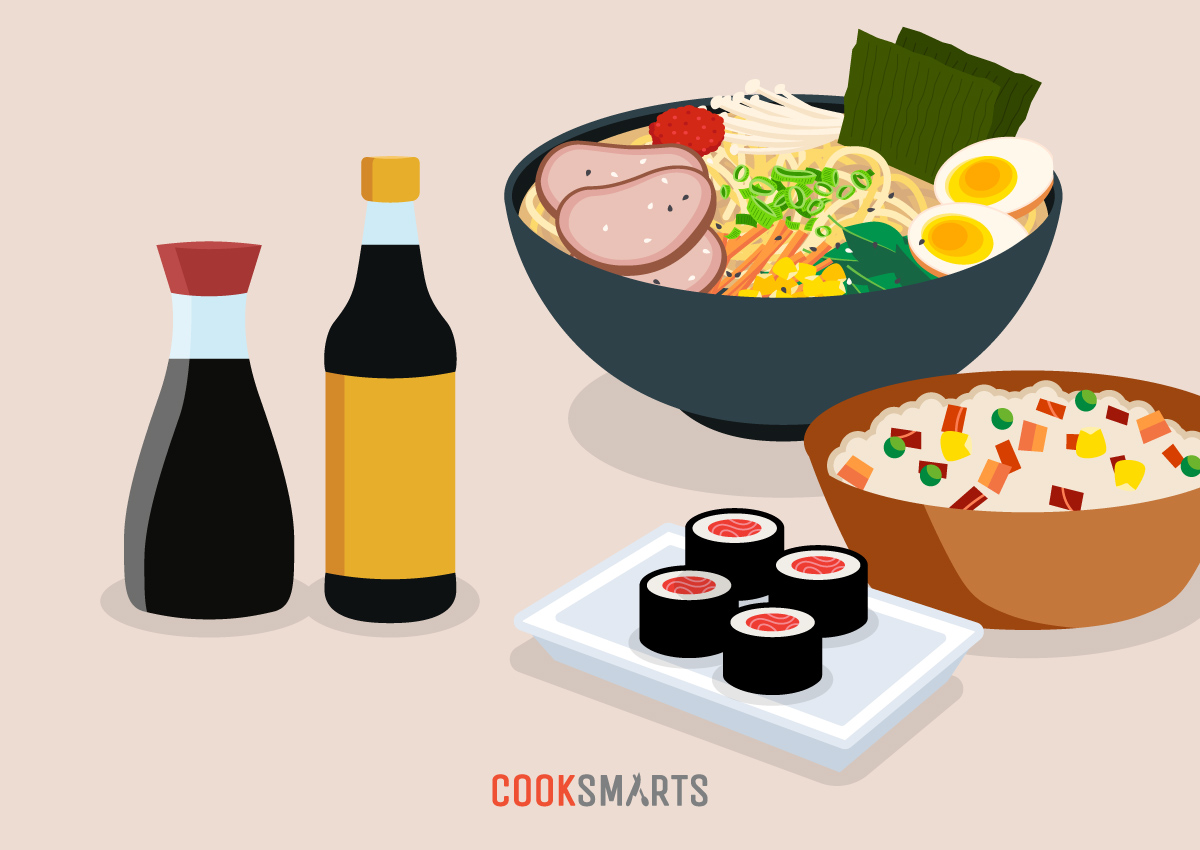
1. Soy Sauce
What is soy sauce?
Soy sauce is a thin, fermented brown sauce made of soybeans, grain (often wheat), salt, and a fermenting agent, traditionally the fungus Aspergillus oryzae or Aspergillus sojae. Modern production techniques sometimes rely on hydrolyzing soy proteins instead of fermenting soybeans, a process in which the soy proteins are broken down by mixing heated soybeans and hydrochloric acid.
What does soy sauce taste like?
Most people, even those who have never cooked Asian foods, are familiar with soy sauce, which adds a salty, umami flavor to many Asian dishes. What you may not know is how many varieties of soy sauce are out there, each with slightly different flavors and uses. These include:
- Japanese soy sauce (also known as shoyu): Bottles just labeled as “soy sauce” in the United States are typically Japanese-style soy sauce. This is the dark, thin version of soy sauce that you’ll find in most Asian-American restaurants. Kikkoman is the best-known brand of shoyu soy sauce.
- Tamari: Tamari is a Japanese style of soy sauce that is not made with wheat. For this reason, it’s popular among people who eat gluten-free, though some tamari can contain traces of gluten; be sure to read the label if this is important to you.
- Light soy sauce: Light soy sauce is a Chinese soy sauce that’s lighter in color and flavor than bottles just labeled “soy sauce” — though if it’s a Chinese brand that doesn’t specify, you can assume it’s light soy sauce. This sauce adds salt to recipes without turning your food as dark or adding as much umami flavor as regular soy sauce. It’s important to note that light soy sauce is not the same as low-sodium soy sauce, though some brands do use the term “light” (or “lite”) on their low-sodium versions. Use light soy sauce anytime the recipe specifies its use, in any Chinese recipe that doesn’t specify the type of soy sauce, or sub it in for regular soy sauce in a recipe. It can also be used for dipping or as a salad dressing ingredient.
- Dark soy sauce: Dark soy sauce, another Chinese version of soy sauce, has a deeper, darker flavor and color than Japanese soy sauce (or Chinese light soy sauce). It’s also a little thicker and sweeter. It contains more sodium than light or regular soy sauce, but actually tastes less salty due to the stronger flavor of the sauce. Dark soy sauce should not be used in place of regular soy sauce in recipes, as it may overpower other flavors. You can, however, use a combination of dark and light soy sauce if you’re out of regular soy sauce.
- Kecap Manis: Kecap Manis is an Indonesian sweet soy sauce that is thicker and sweeter than Japanese or Chinese soy sauces. That’s due to the addition of palm sugar, which gives the sauce a syrupy appearance. It also often contains aromatics such as garlic and ginger, as well as spices such as anise, cloves, and peppercorns. Kecap manis can be used in stir-fries or tossed with noodle dishes, or is great for dipping.
- … And many more! The list goes on. There’s Japanese light soy sauce, white soy sauce, twice-brewed soy sauce, mushroom flavored dark soy sauce, and ganjang (Korean soy sauce), to name just a few. There are also multiple styles of low- or reduced-sodium soy sauce. As you cook a variety of recipes, you’ll build your pantry with the soy sauces you love the most!
How to use soy sauce:
Soy sauce originated in China, but is now used throughout East and Southeast Asia. Soy sauce can be drizzled in ramen, used to dip sushi or sashimi, or drizzled to add additional flavor to stir-fries or other Asian dishes that need a little more oomph. It’s also a common ingredient in sauces, soups, marinades, salad dressings, fried rice, and noodle dishes.
Best substitute for soy sauce:
Soy sauce’s primary purpose is to add salt and umami flavor to a dish, so the best substitutes are ingredients that also provide salt and umami.
- Liquid aminos are a good choice, as is miso paste, fish sauce, or Worcestershire sauce.
- You may also have bottled sauces in your fridge that contain soy sauce and could be used in a pinch, such as “stir-fry sauce” or teriyaki sauce; you may need to dial down other flavors in a recipe if you take this route, such as using less sugar if you use teriyaki sauce in place of soy sauce.
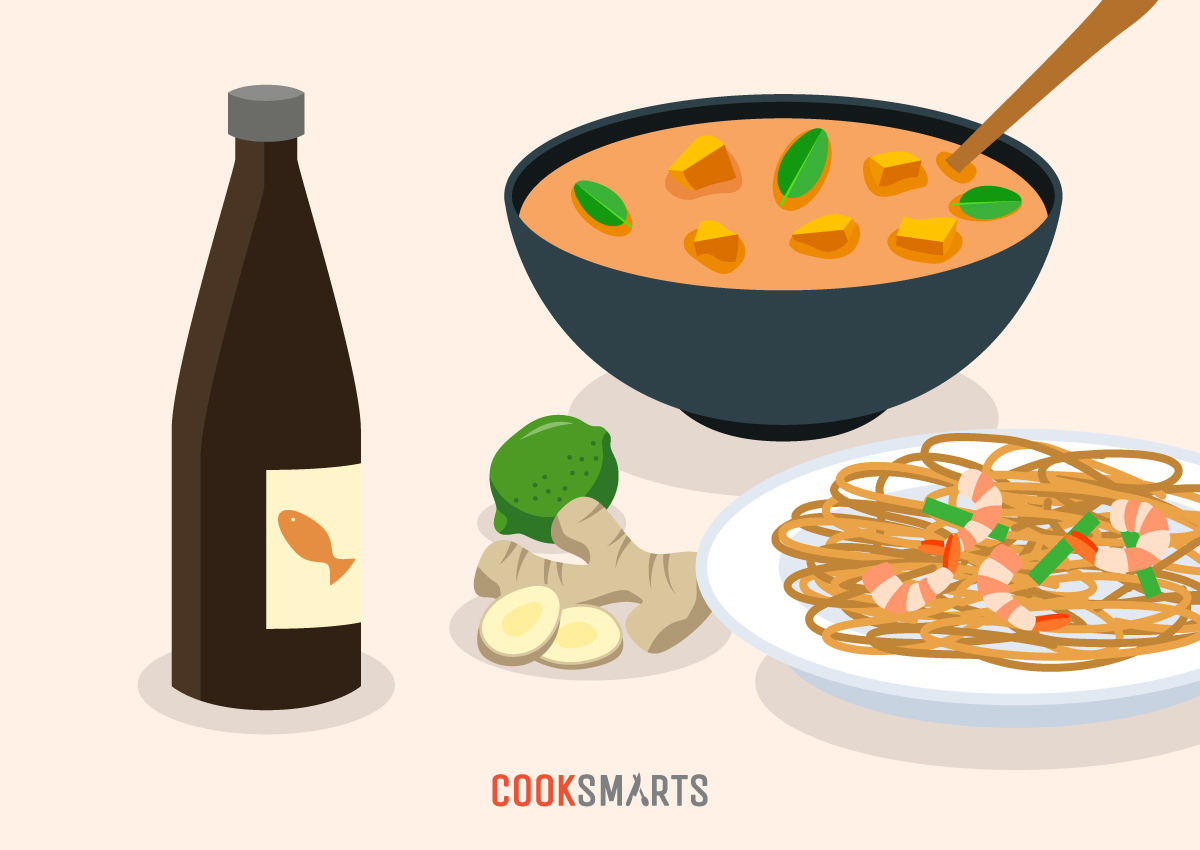
2. Fish Sauce
What is fish sauce?
Fish sauce is a thin liquid made from anchovies, mackerel, shrimp, or krill fermented with salt.
What does fish sauce taste like?
Fish sauce adds salty, umami flavors to food and has a decidedly fishy taste on its own, but adds balance to East and Southeast Asian dishes when used in moderation. Due to the variety of types of seafood that can be used to make fish sauce, as well as differing fermentation methods, different brands of fish sauce can taste very different from one another.
How to use fish sauce:
Fish sauce is found particularly often in Thai, Vietnamese, and Indonesian cuisines, where it’s combined with ingredients such as soy sauce, lime juice, chili oil, garlic, ginger, sugar, and more. It’s an essential ingredient in Pad Thai and many other takeout favorites, and is also used in soups, stews, stir-fries, marinades, and vinaigrettes. At home, fish sauce can be used to up the flavor in instant ramen or any Asian dish that needs more savory depth.
Best substitute for fish sauce:
- The best substitutes for fish sauce add salt and umami flavors along with a hint of — for lack of a better word — the ocean. If you’re looking to sub fish sauce because you’re vegetarian or vegan, know that vegan fish sauce does exist.
- But if you’re just plain out, you can use soy sauce mixed with equal parts rice vinegar, oyster sauce, coconut aminos, anchovies, or Worcestershire sauce.
- In a soup, you can also add seaweed such as nori, kombu, or wakame in place of fish sauce.
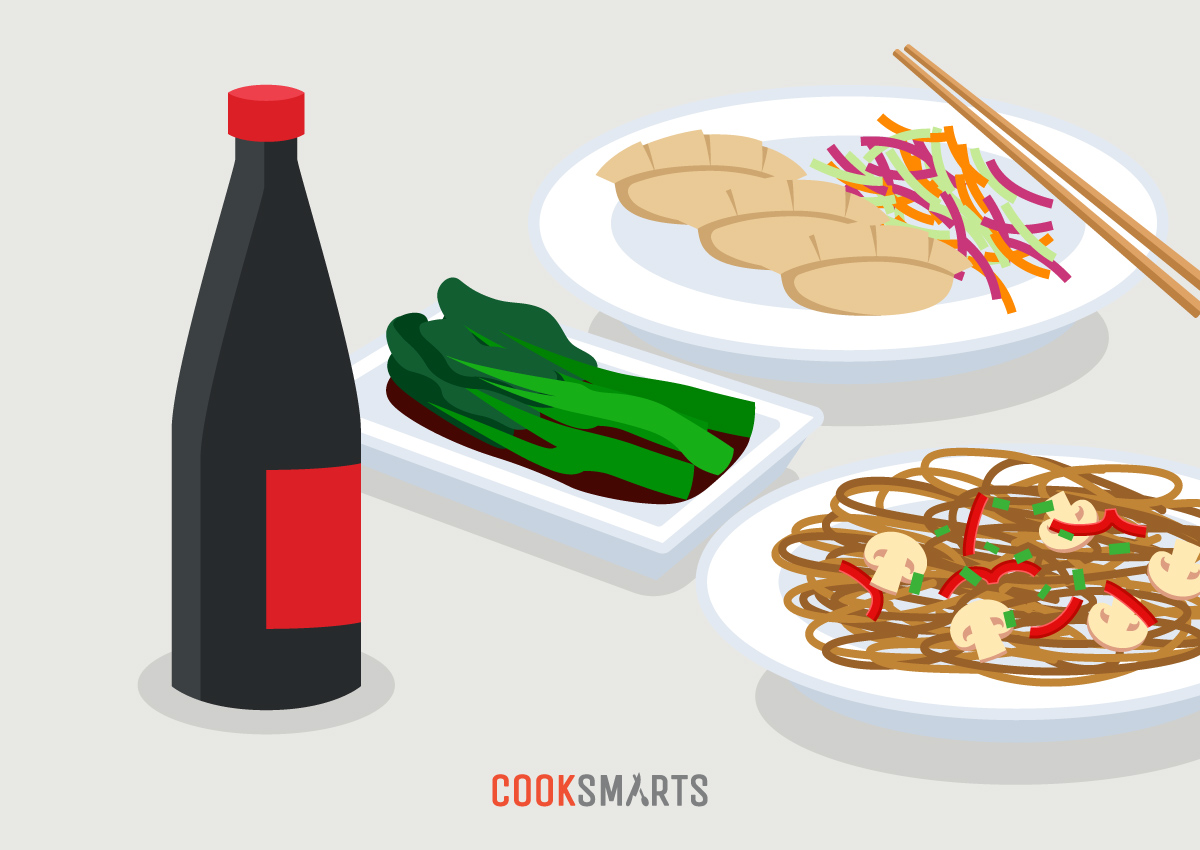
3. Oyster Sauce
What is oyster sauce?
First, let’s get this one out of the way: Yes, oyster sauce is made of oysters. But it’s so much more than that! Oyster sauce is a thick, dark brown fermented sauce made of oysters, salt, sugar, and more.
What does oyster sauce taste like?
It doesn’t taste like oysters; it is briny, rich and caramelly, and has a fishy umami flavor. If you’ve ever had Chinese food, chances are good you’ve tasted oyster sauce, which is a primary ingredient in many Chinese brown sauces.
How to use oyster sauce:
Oyster sauce is frequently used in marinades, soups, stir-fries, and dumpling fillings, or can also be used on its own drizzled on top of meats or vegetables.
Best substitute for oyster sauce:
- Hoisin is a reasonable substitute for oyster sauce because it’s similarly thick and lightly sweet.
- You could also use soy sauce with some sugar (or kecap manis, if you have it).
- Teriyaki sauce or another bottled Asian sauce could also serve a similar function.
- If you’re missing the brininess of oyster sauce, add a dash of fish sauce in addition to the substitutions mentioned here.
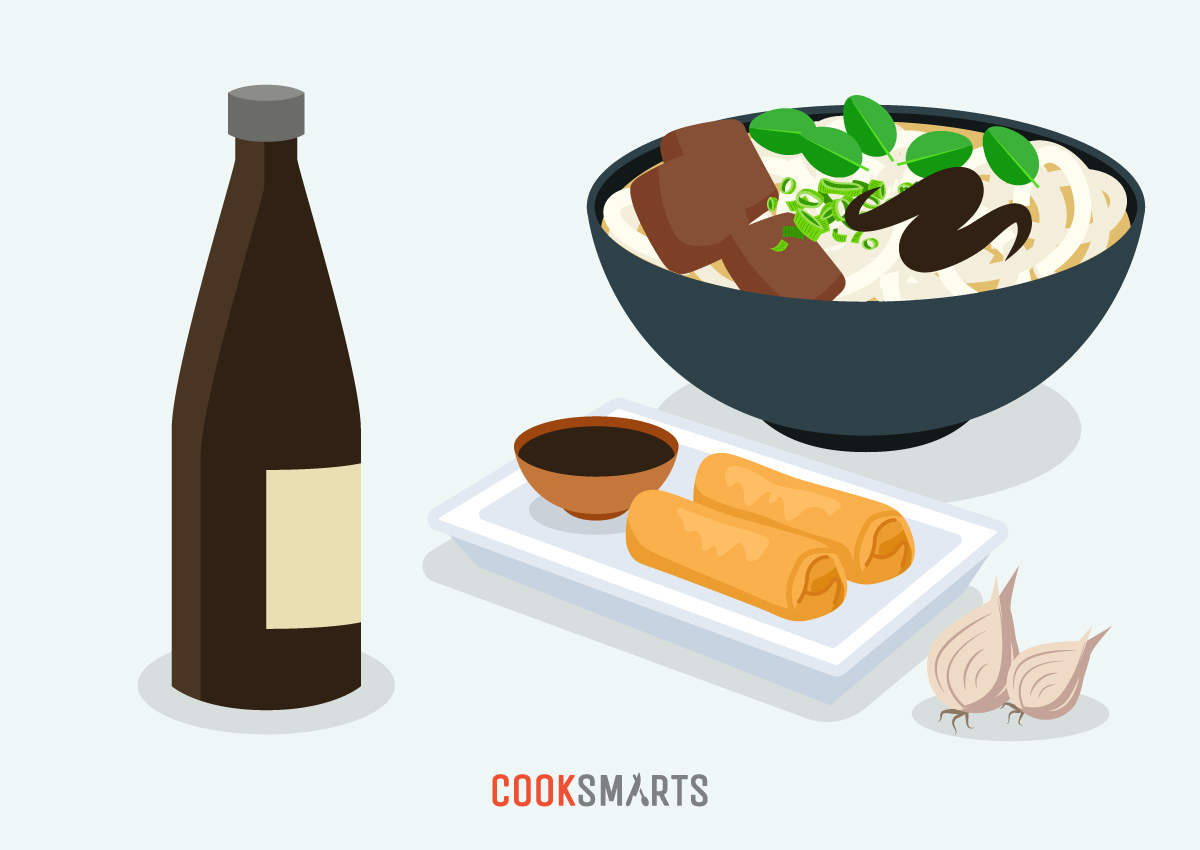
4. Hoisin Sauce
What is hoisin sauce?
Hoisin sauce is a thick, dark-colored Cantonese sauce made of fermented soybean paste and additional flavors.
What does hoisin sauce taste like?
Hoisin is both sweet and salty. Though there are many different hoisin recipes, hoisin usually contains garlic, 5 spice powder, vinegar, and sugar. It often has some heat from chili peppers as well.
How to use hoisin sauce:
Hoisin can be used as a dipping sauce, or as a condiment to put on top of finished meat, noodle, or veggie dishes. It can be added to soups such as pho. It’s also frequently used as a marinade or glaze, either by itself or as a component in a more complex mixture, and is frequently used as a sauce ingredient.
Best substitute for hoisin sauce:
- Homemade hoisin sauce recipes abound online, with most using peanut butter or miso paste to approximate the flavor of the fermented soybean paste — or you can use black bean sauce (which is actually made of black soybeans) if you have it.
- In a pinch or as a part of a more complex recipe, you can also use just one of those ingredients above along with brown sugar, molasses, or honey.
- For recipes where hoisin sauce is a primary ingredient, it’s worth it to add additional ingredients to round out the flavor, such as garlic, chilis, and 5 spice powder.
- Teriyaki sauce can also be substituted for hoisin since it contains a similar sweet-salty balance.
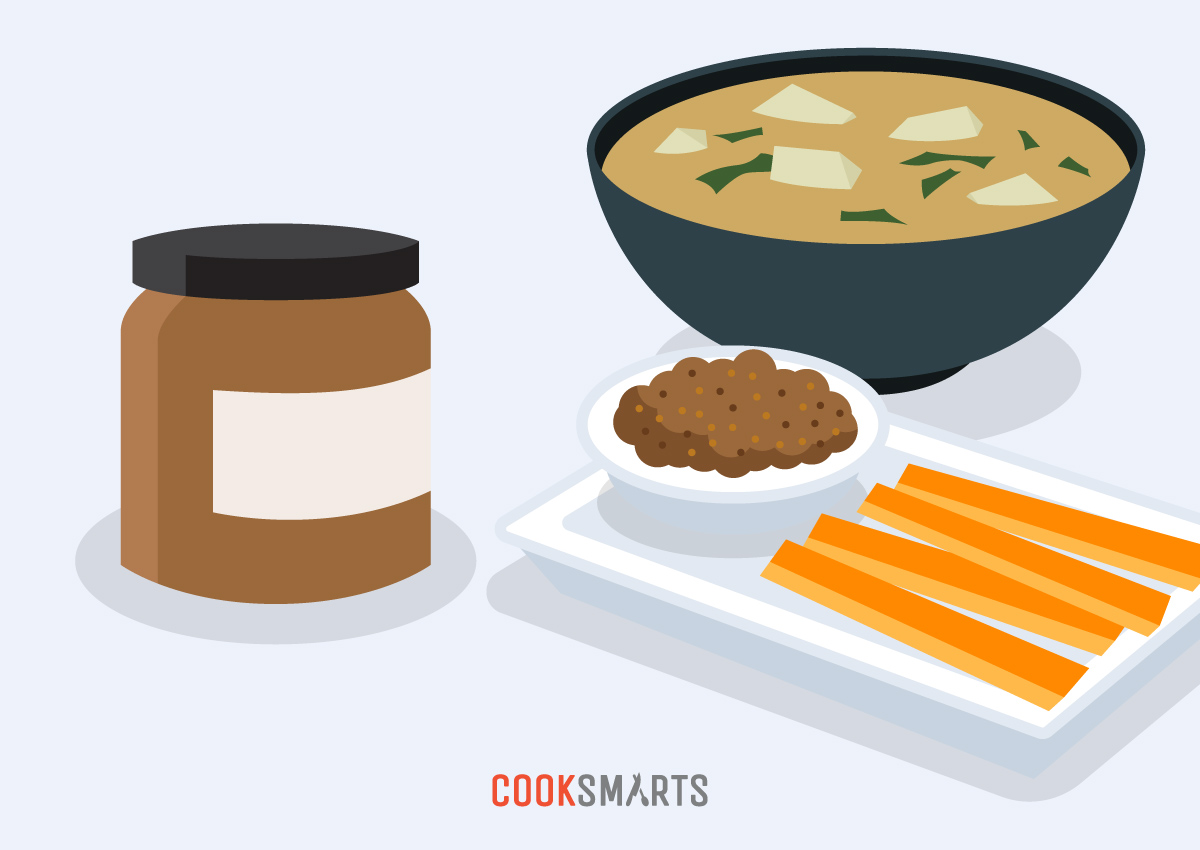
5. Fermented Bean Paste
What is fermented bean paste?
Fermented bean pastes, usually made from soybeans, are used as a condiment in a variety of Asian cultures’ cuisines. Outside of Asia, miso paste is the most well-known type of fermented bean paste, but there are many others as well — Korean doenjang, Nepalese kinema, and Vietnamese tương, to name just a few. Fermented bean pastes are sometimes referred to as bean sauce, as in the case of Chinese black bean sauce, which is made of fermented black soybeans.
What does fermented bean paste taste like?
Fermented bean pastes tend have a strong, pungent umami flavor, and are usually quite salty due to the salt used in the fermentation process. However, flavors can vary depending on the type of beans used, the specific strains of bacteria or mold used to ferment, production methods, and other ingredients that are sometimes added, such as sugar or chilis.
How to use fermented bean paste:
Fermented bean pastes can be mixed with other ingredients and turned into a dip for veggies, or as an ingredient in sauces, soups, dressings, or other dishes.
Best substitute for bean paste:
- If you don’t have a specific type of fermented bean paste a recipe calls for, your best bet is to sub some other type of fermented bean paste or sauce, such as miso.
- You could also try a product that contains fermented beans as an ingredient, such as hoisin sauce.
- As we mentioned above, note that “black bean paste” and “black bean sauce” are the same thing, so if you’re out of fermented bean paste but have black bean sauce, you’re in luck!
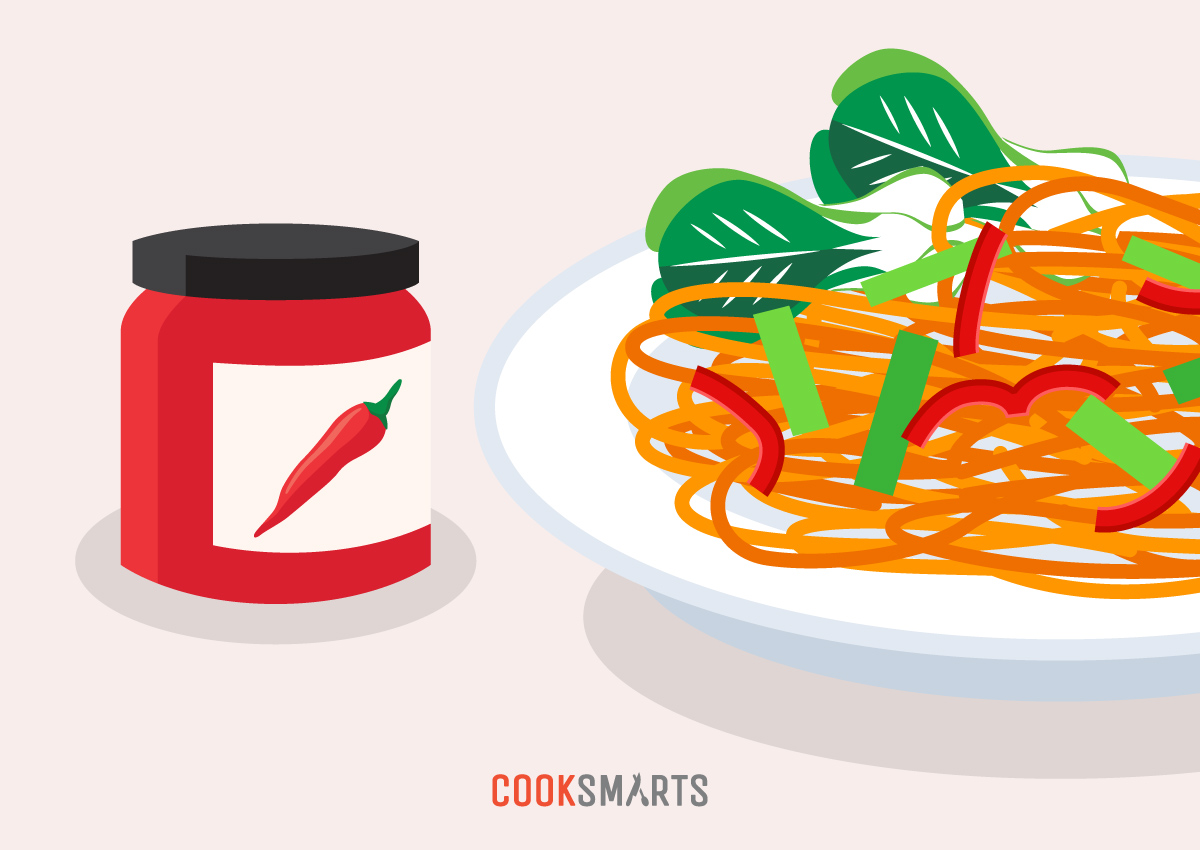
6. Chili-Garlic Sauce
What is chili-garlic sauce?
Chili-garlic sauce is a thick, coarse sauce made primarily from chili pepper flakes, garlic, salt, and vinegar. It’s of Chinese or Vietnamese origin.
What does chili-garlic sauce taste like?
This sauce’s primary purpose is to add heat to dishes, but under the spiciness it has a rich, balanced, garlicky flavor.
How to use chili-garlic sauce:
Because chili-garlic sauce contains few ingredients and no spices or herbs, it goes well in a wide variety of dishes. It can be used to add heat to soups, especially ramen and other Asian soups. It’s a common ingredient in sauces and marinades, and is commonly found in Asian noodle dishes. It can also be spooned onto finished stir-fries, meats, or noodle dishes, but this is less common since it’s fairly thick for its spice level, which means it’s easy to get a mouthful of heat!
Best substitute for chili-garlic sauce:
- Harissa or red pepper flakes make a decent substitute for chili-garlic sauce.
- Sriracha or other types of hot sauce can also be used in many recipes.

7. Sriracha
What is sriracha?
Sriracha is a smooth hot sauce commonly used in Thai and Vietnamese cuisine. Its consistency is similar to ketchup. It is bright red-orange in color, and is made from chili peppers, vinegar, garlic, and sugar. Unlike chili-garlic sauce, sriracha is fermented.
What does sriracha taste like?
Sriracha is a hot sauce, so unsurprisingly, it tastes spicy! It’s also very lightly sweet with a hint of garlic and a bit of tanginess from the fermentation process.
How to use sriracha:
Sriracha is frequently used to finish dishes such as stir-fries and grain bowls since it can be squirted onto a meal in attractive, thin red lines that add visual contrast. It’s used on all types of Asian dishes, but is also great on Mexican, Southwestern, and American dishes, including chilaquiles, veggie hash, frittatas, avocado toast, spicy mac ‘n’ cheese, or soups. It can also be added to Bloody Marys, and is frequently used as an ingredient in sauces and marinades.
Best substitute for sriracha:
- Any hot sauce can be used in place of sriracha, but Indonesian hot sauce sambal oelek may be your best bet.
- Tapatio, gochujang, harissa, or chili-garlic sauce are also good options.
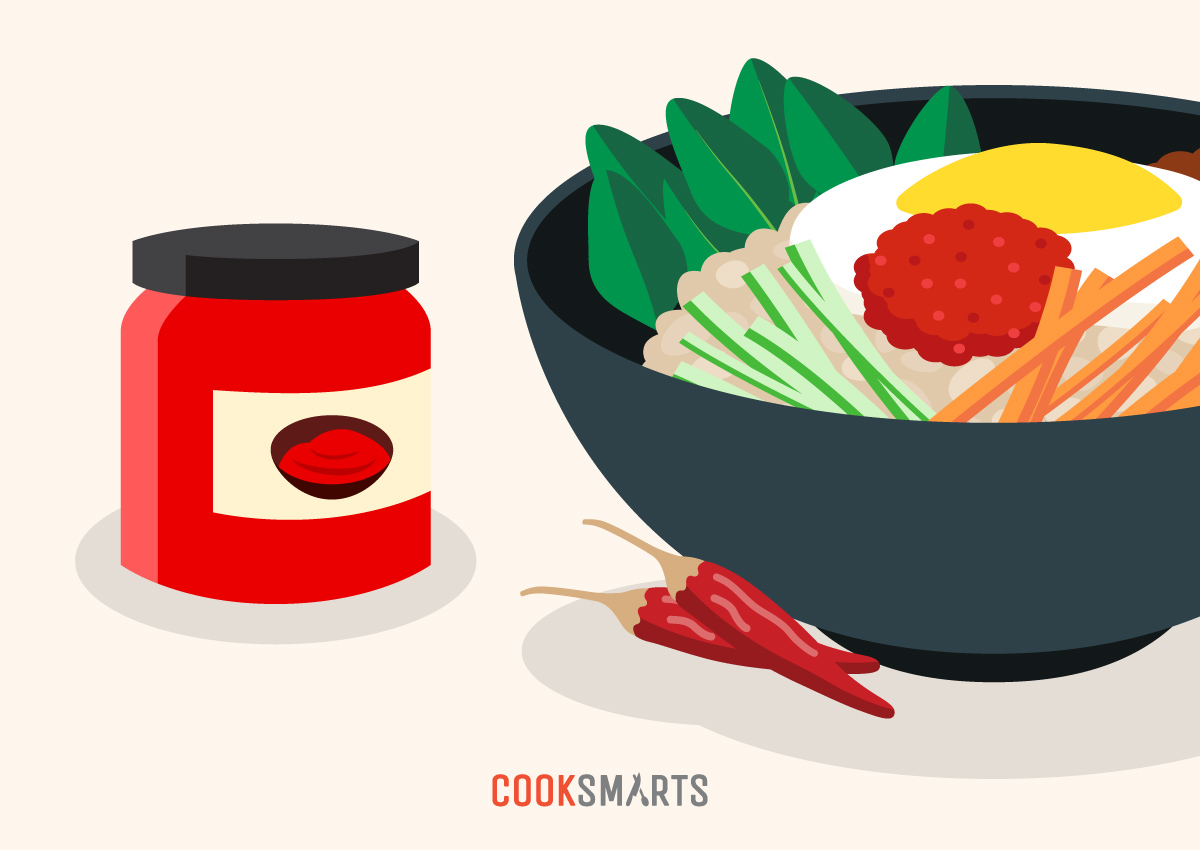
8. Gochujang
What is gochujang?
Gochujang is a Korean chili paste made from chili pepper flakes, fermented soybeans, glutinous rice, and salt. It is dark red in color and thick and fairly smooth in texture.
What does gochujang taste like?
Gochujang boasts a mix of spicy, umami, and sweet flavors. It has a distinctive flavor sometimes described as a “funk” thanks to the fermented soybeans and a slow-building heat that can vary depending on the brand, so try a few until you find one you love.
How to use gochujang:
While gochujang can theoretically be used on its own, it’s much better as a component in a sauce or marinade, especially for meats or seafood. Mix it with sesame oil, a touch of sweetener such as honey or brown sugar, and some rice vinegar for an easy, delicious sauce that can top veggies, be tossed with noodles, or used to dip meat.
Best substitute for gochujang:
- The adobo sauce from a can of chipotles in adobo is a decent substitute for gochujang.
- You can also use sriracha or chili-garlic sauce.
- Add a little miso paste to whatever you’re making if you miss the fermented flavor that gochujang provides.
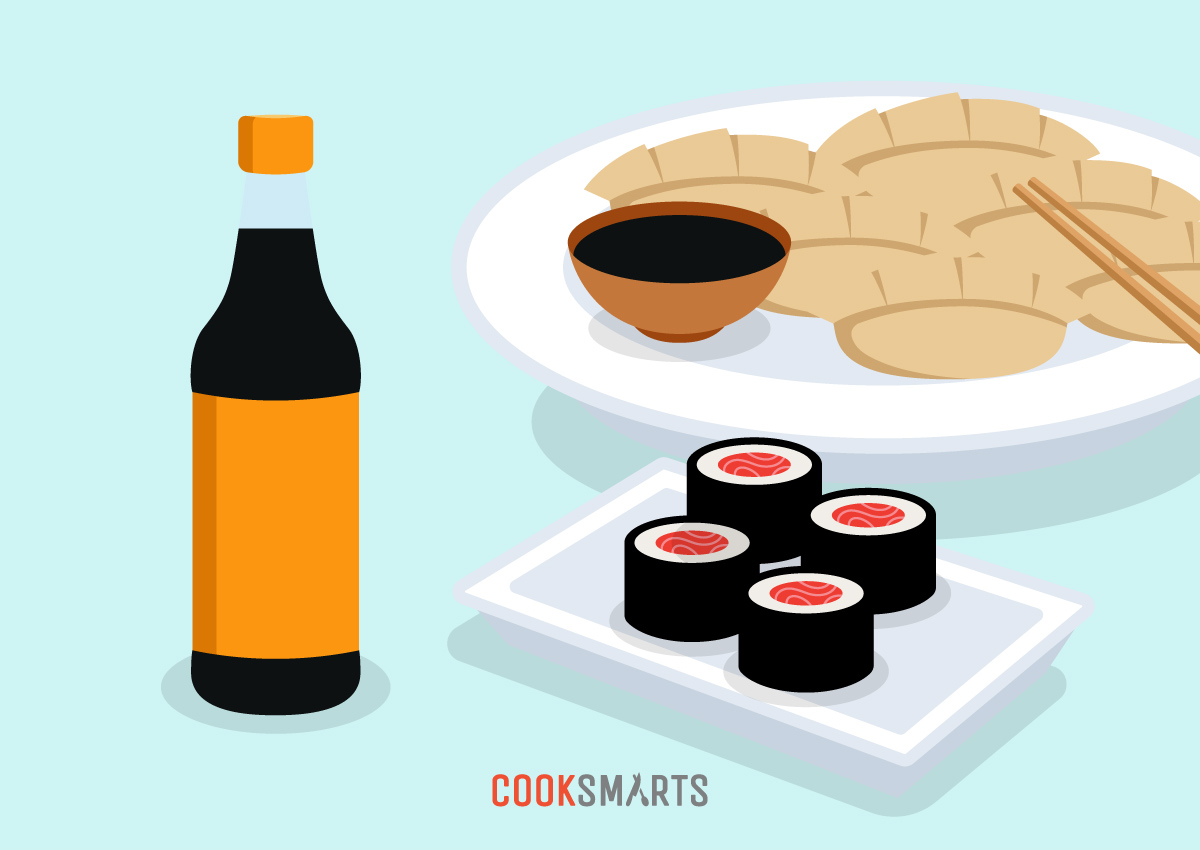
9. Ponzu Sauce
What is ponzu sauce?
Ponzu is a thin, citrus-based sauce of Japanese origin. It’s traditionally made with yuzu, though other types of citrus are sometimes used. It also contains mirin, rice vinegar, katsuobushi flakes, and kombu seaweed, and soy sauce is often added to the finished product. Technically, when soy sauce is added, the sauce is called “ponzu shoyu,” though it is often simply referred to as “ponzu.”
What does ponzu sauce taste like?
Ponzu is tart and tangy with a pronounced citrus flavor. It’s also balanced by sweet and salty flavors and a hint of bitterness, similar to a vinaigrette.
How to use ponzu sauce:
Ponzu can be used to dip sushi, noodles, dumplings, or meat, or it can be used as a salad dressing. It can also add balance to finished dishes such as stir-fries, soups, or stews, and is a common ingredient in marinades and sauces.
Best substitute for ponzu sauce:
If you can’t find ponzu sauce, try making your own version at home. Though you may not have all of the ingredients needed for authentic ponzu, you can get pretty close to the flavor with a combination of soy sauce, rice vinegar, mirin (or additional rice vinegar with a pinch of sugar), orange juice, and lemon juice.

10. Sweet Chili Sauce
What is sweet chili sauce?
Sweet chili sauce, or nam chim kai, is a Thai sauce with a thin, syrupy consistency. It has a clear red or orange color, as compared to the opaque reds of sriracha, chili-garlic sauce, and gochujang. It typically contains Thai red chili pepper flakes, some type of sugar, rice wine vinegar, garlic, salt, and fish sauce, and is often thickened with cornstarch.
What does sweet chili sauce taste like?
The most prominent flavors in sweet chili sauce are right there in the name: sweetness, from sugar, honey, or fruit, and spiciness, from red chili peppers. It also contains a tanginess from the vinegar, similar to sweet and sour sauce.
How to use sweet chili sauce:
Sweet chili sauce makes a great dip for veggies, egg rolls, or shrimp. It also works well as a marinade on chicken, pork, or seafood, or can be spooned over a finished dish to add sweetness and heat. It’s often used in stir-fries alongside soy sauce, garlic, ginger, green onions, lime, and/or sesame oil.
Best substitute for sweet chili sauce:
- Honey and hot sauce mixed in your preferred proportions (we recommend starting with 3:1) is a great easy substitute for sweet chili sauce.
- If you have a little more time or the sauce will feature prominently in your meal, recipes for homemade sweet chili sauce abound and are quick to make.
If this list of Asian sauces and condiments is useful to you, stay tuned for more helpful resources by signing up for our weekly email below. Or sign up for a free 14-day trial of our meal plan service for a variety of delicious, fresh, and healthy dinner ideas!
